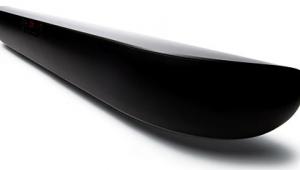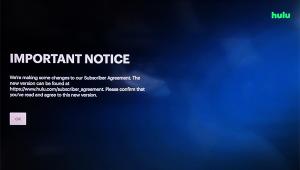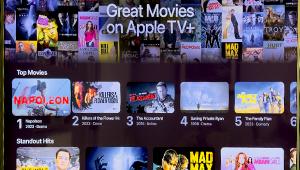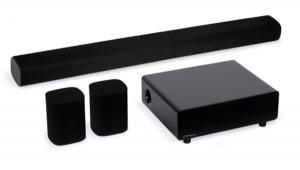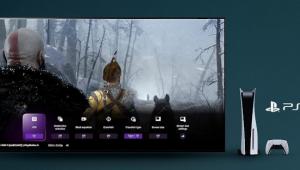Sonos Digital Music System
Not to sound cynical, but, at this stage of the distributed audio game, "me too" products don't cut it anymore. What we want is something new, something different, something better. Luckily for Sonos, that's what their Digital Music System delivers. Much of the allure in these gray and silver boxes lies in the freedom they promise. It's not just a question of wired or wireless—although wireless is an option here, sort of, and it's mighty desirable. This system is also independent from the computer, so that you can connect it to a PC, a Mac, or even Linux—or directly to a network storage drive for even greater flexibility.
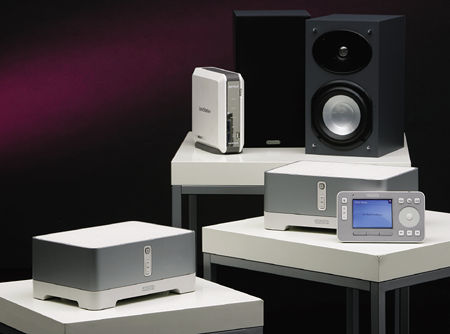
What Else Is New?
A Sonos Digital Music System consists of one or more ZP100 ZonePlayers, which receive, decode, and amplify MP3, MP4 (AAC), unprotected WMA tracks, WAV, AIFF, OGG vorbis, and FLAC. The system also uses the Rhapsody subscription music service and a single CR100 controller. The controller is slightly smaller than a paperback book and has a high-capacity, rechargeable lithium-ion battery and a large color screen. There are hard keys for volume, mute, skip, play/pause, music, and zones, as well as multifunction buttons for the selected operation. It also has an iPod-style wheel with a selector button in the center. Optional Sonos-branded bookshelf speakers are also available, equipped with 10-foot runs of hearty 14-gauge speaker cable.
If you choose the PC/Mac path, you must hardwire the first ZonePlayer in a Sonos system to the computer's router to assure a certain quality of performance without introducing third-party wireless adapters. You could also hardwire it directly to the computer and then out to the router from one of the player's four network ports. This setup offers higher performance on any subsequent players, even if any or all are linked wirelessly. Right out of the box, the ZonePlayers are ready to create their own Sonosnet wireless network. Instead of linking to a central access point (i.e., a Wi-Fi router), each player creates and extends a mesh network, which allows each unit to connect wirelessly to any other nearby unit within a 100-foot range and without line-of-sight. The more ZonePlayers you're using, the larger and stronger your wireless footprint. Since it is a smart system, Sonos automatically selects the best signal path for your home. A reliable, resilient network translates to more music and less grief. This is the first consumer electronics product to use this new wireless mesh networking technology, although you can also set it up in a wired configuration to suit your individual needs.
Want to play God, or perhaps just be really obnoxious? You can be listening to the player in the basement and control the music out on the front-porch player. The controller communicates with whichever player is closest, but thereby has access to the entire system, even players beyond the range of the controller, via relay through the mesh network.
Meanwhile, Back at the Keys. . .
You can also fully control the Sonos system from the computer for a beneficent deity/mad scientist effect. The Sonos Desktop Controller application arrives on CD and establishes the initial communication between computer and player(s), conveniently naming each by its location (Living Room, Bedroom, etc.) from a drop-down menu. You can choose to share folders of music on the computer with the Sonos system, as the Desktop Controller approves each folder and then indexes it for use on the system, similar to importing tracks for computer-jukebox applications. Registering your hardware with Sonos also makes you eligible for free software upgrades, such as new format compatibility. A software update to the wired-in ZonePlayer was remarkably quick, and the same update to a remote player in another room was only slightly slower. At a couple of points in the process, I had to modify my firewall to permit the Sonos system to access my existing home network, but this was as simple as clicking yes or no. On the desktop, you can also tweak the sound via a virtual equalizer, for individual players or for the entire system.
Onscreen prompts offer the option to add another player immediately, but, instead, I chose to do so later from the ZonePlayer's drop-down menu. Once I'd named the zone, I had two minutes to hit two keys on the new player to let Sonosnet know where the new unit was, and the software basically did all the rest of the work. My only duties were to secure an AC power source and connection to either a pair of speakers, via the spring-loaded binding posts (bare-wire termination), or to a receiver, which would utilize the ZonePlayer's analog stereo out with a dedicated sub preout. Unboxing and hooking up the gear is not especially difficult, but those simple steps are what took the most time. The ZonePlayer itself is an unexpectedly hefty piece of hardware, owing to the rated 100 watts of amplification inside the trim chassis. Despite its putty color, it is not to be mistaken for a computer peripheral.
The newly offered Sonos SP100 bookshelf loudspeakers also seem to be quite the bargain at $179 per pair. Compressed audio tracks are not the best test of sound reproduction, so I patched in a CD player via the amplifier's analog stereo input. The speakers quickly revealed impressive clarity, detail, and dynamic range. These speakers are also remarkably well built, and, combined with the solid amplification, they delivered some of the best sound quality I've heard from a digital music-sharing device. Also worth noting is that you can distribute patched-in analog devices throughout the network: Imagine a virtual turntable, anywhere.
Two antennae hidden inside the player's feet assured smooth operation, even when I placed the ZonePlayers the specified maximum 100 feet apart. The walls of Rancho Chiarella are paper-thin, though, and I wasn't microwaving any burritos during my review. Multiple players can each handle an independent music stream. Or you can link all to play the same stream with perfect synchronization of the players, even after extended periods. As I said earlier, the Sonos Digital Music System is not PC-dependent, so an outboard hard drive like the loaner Buffalo LinkStation that Sonos sent me can be quite liberating, parking 120 gigabytes of music wherever it's convenient, again fully accessible from any networked player. The main drawback to this approach is the loss of Internet connectivity and its potential benefits.
The Not-So-Secret Weapon
I've never seen a remote quite like the CR100. It's wonderfully interactive via the backlit buttons all over its face, and it's designed solely for operation of the Sonos system. After a brief wait for the remote to start up, maybe 10 to 15 seconds, it establishes a wireless connection with one of the players, then with additional players within range of the first, with only a short additional lag time. The CR100 can even update its own internal software wirelessly, without interrupting music playback. You can choose to update your ZonePlayer software without wires, too, but playback will then be disrupted for about two minutes. It was on the remote that I discovered that the system software also provides many Internet radio stations automatically, through the computer, with fast, easy access and lots of pertinent information provided on the bright, colorful screen, which also displays album-cover artwork as available. Juggling the operation of multiple players is a snap with just the one controller. If the setup is computer-based, the Sonos Desktop application does not need to be open for the system to work, but the PC/Mac does need to be powered up. Strangely, the ZonePlayer units never fully shut down; they pause or mute, eventually entering a sleep mode.
With technology that is both bold and successful, wrapped in a design that is at once striking yet décor- and user-friendly, Sonos has created a highly adaptable multiroom music system that suits technophile and audiophile alike.
Highlights
• A truly elegant way to enjoy your digital music collection anywhere you want it
• First with a mesh network: More players mean broader, stronger coverage
• Ample Ethernet ports for wired homes; built-in wireless, too (no elaborate accessories needed)
- Log in or register to post comments









